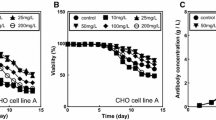Abstract
It is generally accepted that the phase of cell decline observed in batch culture of mammalian cells is related to exhaustion of medium nutrients (principally glucose and glutamine) and/or to waste products accumulation. In the present paper, we have studied the influence of glutamine on the proliferation of mouse hybridoma cells. We showed that repeated addition of glutamine prolonged the life span of the culture and significantly increased the secretion of monoclonal antibody. Flow cytometry analysis suggests that this effect of glutamine is related to a delay in cell death rather than to a stimulation of proliferation.
Addition of glutamine and glucose failed however to prevent the death of the culture. Determinations of amino acid consumption in glutamine-supplemented samples and experiments carried out with complementary sources of amino acids (e.g. tryptose phosphate) strongly suggest that amino acid supply is a critical factor governing cell growth and productivity.
Similar content being viewed by others
References
MacMillanJD, VelezD, MillerL and ReuvenyS (1987) Monoclonal antibody production in stirred reactors. In: Large scale cell culture technology, BKLyderse (ed) Hanser Publishers Munich, pp. 21–58.
DodgeTC, JiGY and HuWS (1987) Loss of viability in hybridoma cell culture. A kinetic study. Enzyme Microb. Technol. 9; 607–611.
GriffithsJB and PirtSJ (1967) The uptake of amino acids by mouse cells (Strain LS) during growth in batch culture and chemostat culture the influence of cell growth rate. Proc. Roy. Soc. B. 168: 421–438.
LambertK and PirtSJ (1975) The quantitative requirements of human diploid cells (Strain MRC-5) for amino acids, vitamins and serum. J. Cell. Sci. 17: 397–411.
MizrahiA and AvihooA (1977) Growth medium utilization and its re-use for animal cultures. J. Biol. Standard 5: 31–37.
ButlerM, ImamuraT, ThomasJ and ThillyWG (1983) High yields from microcarrier cultures by medium perfusion. J. Cell. Sci. 61: 351–363.
ArathoonWR and TellingRC (1982) Uptake of amino acid and glucose by BHK 21 clone 13 suspension cells during cell growth. Develop. Biol. Standard 50: 145–154.
Seaver SS, Rudolph JL and Gabriel JE (1984) A rapid HPLC technique for monitoring amino acid utilization in cell culture. Biotechniques 254–260.
KimuraT, IijimaS and KobayashiT (1987) Effect of lactate and ammonium on the oxygen uptake rate of human cells. J. Ferment. Technol. 65: 341–344.
HasegawaA, YamashitaH, KondoS, KiyotaT, HayashiH, YoshizakiH, MurakamiA, ShiratsuchiM and MoriT (1988) Proteose peptone enhances production of tissue-type plasminogen activator from human diploid fibroblasts. Biochem. Biophys. Res. Comm. 150: 1230–1236.
EagleH (1955) Nutrition needs of mammalian cells in tissue culture. Science 122: 501–504.
ReitzerLJ, WiceBM and KenellD (1979) Evidence that glutamine, not sugar, is the major energy source for cultured Hela cells. J. Biol. Chem. 254: 2669–2676.
McKeehanWL (1982) Glycolysis, glutaminolysis and cell proliferation. Cell Biol. Internat. Reports 6: 635–650.
Flickinger MC, Goebel NK, Bohn M, Biliba D and Karl DW (1988) L-glutamine stimulated 9.2.27 monoclonal antibody synthesis and evidence for immunoglobulin heterogeneity during very slow hybridoma growth. Abstr. Pap. Am. Chem. Soc. 195th meet.
HolleyRW and KiernanJA (1974) Control of the initiation of DNA synthesis in 3T3 cells: low molecular weight nutrients. Proceed. Natl. Acad. Sci. U.S.A. 71: 2942–2945.
KohnA (1975) Differential effects of isoleucine deprivation on cell motility, membrane transport and DNA synthesis in NIL 8 Hamster cells. Exptl. Cell Res. 94: 15–22.
ZetterbergA and EngstromW (1981) Glutamine and the regulation of DNA replication and cell multiplication in fibroblasts. J. Cell Physiol. 108: 365–373.
EngstromW and ZetterbergA (1984) The relationship between purines, pyrimidines, nucleosides, and glutamine for fibroblast cell proliferation. J. Cell. Physiol. 120: 233–241.
LuanYT, MutharasanR and MageeWE (1987) Strategies to extend longevity of hybridomas in culture and promote yield of monoclonal antibodies. Biotechnol. Letters 9: 691–696.
Author information
Authors and Affiliations
Rights and permissions
About this article
Cite this article
Geaugey, V., Duval, D., Geahel, I. et al. Influence of amino acids on hybridoma cell viability and antibody secretion. Cytotechnology 2, 119–129 (1989). https://doi.org/10.1007/BF00386144
Received:
Accepted:
Issue Date:
DOI: https://doi.org/10.1007/BF00386144




